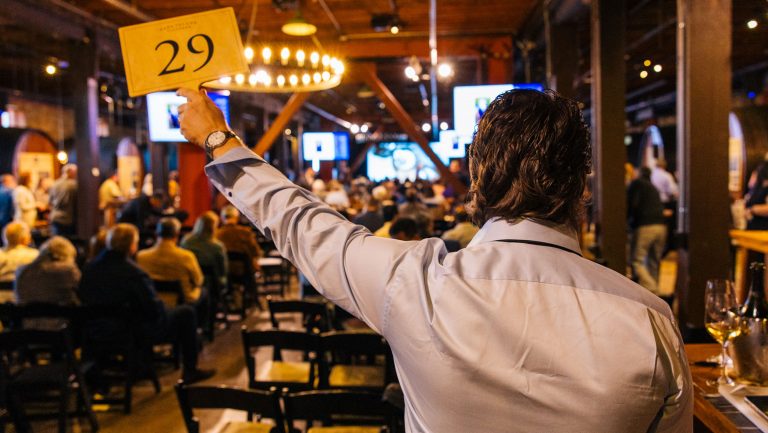Just over a decade ago, somewhere between the bag-in-box and canned wine revolution, draft wine, or wine on tap, exploded onto the U.S. market, billed as the next big thing in on-premise wine service. With the simple pull of a handle, bar and restaurant staffers could swiftly and easily pour a range of wines in whatever quantity the consumer desired. Following in craft beer’s footsteps, wine would move from bottle to keg on a grand scale.
Fast-forward to today and the reviews for wine on tap are mixed across all segments of the beverage industry. Some refer to draft wine as a short-lived fad that has tapered off over time; other producers, wholesalers, and restaurant operators have doubled down on wine on tap, pointing to a serious track record of sales—and potential for future growth.
Though kegged wine remains a relatively small slice of the wine production pie, after withstanding the pandemic and cutting through industry traditionalism, it appears set to grow in popularity. It’s become especially attractive for new or revamped restaurants and wine bars in today’s operating environment, thanks to kegged wines’ profit potential, eco-friendliness, and ease of use. What’s the state of the wine on tap market in the U.S.—and what’s ahead?

Don’t miss the latest drinks industry news and insights. Sign up for our award-winning newsletters and get insider intel, resources, and trends delivered to your inbox every week.
A Trajectory of Growth
According to sales numbers alone, producers of wine in kegs report that the draft wine market is booming. Gotham Project, one of the first keg-dominant producers to really make waves in the U.S. market, makes wine from grapes grown in New York, California, and Washington, and imports wines from several European countries, along with Argentina, Chile, and New Zealand. What started as a brand hocking a Finger Lakes Riesling on tap a dozen years ago now boasts partnerships with fast-casual food chains like Shake Shack, bringing draft wine to the masses.
The project bottles nothing. Eighty percent of production goes to keg while the balance is canned. “Keg sales have grown significantly since we started in 2010,” says Bruce Schneider, a managing partner at Gotham. He says keg sales have risen some 25 percent for Gotham over the last year alone. “The growth has been pretty evenly distributed across restaurants and wine bars,” he adds.
Lauded Willamette Valley winemaker Ken Wright has seen similar traction for his small but growing keg program at Ken Wright Cellars. While the vast majority of Wright’s wine is bottled, he began putting some in kegs after being approached by Sixty Vines, a Texas-based franchise, in 2015.
“They had a casual but high-end approach to both wine and food service,” says Wright, noting that the chain has a substantial draft wine list. While just five percent of Ken Wright Cellars production goes to keg, that number is poised to increase, and kegs of Ken Wright wine are now available in 12 states.
It’s not only attractive for certain restaurants and bars, but in the tasting room as well, where Wright says there’s almost always a tapped keg.

Michael Cook, the director of sales for Lieb Cellars and Bridge Lane Wine in New York, says demand for wine by the keg has increased steadily since they started, back in 2010. After a brief dip during the pandemic, the brand is back to kegging a substantial percentage of its overall wine production, to the tune of 25 percent.
Jordan Sager, the co-president of Illinois-based wine importing company Winesellers, Ltd, which first got into keg wine in 2013, echoes as much. “Keg sales were growing every year until COVID, and for obvious reasons started to slide,” he says. “Since lockdowns ended and restaurant sales have come back, we have seen a return to wine on tap popularity.”
Residual Hangups and Challenges
Why, then, does it seem like much of the fervor around wine on tap has died down over the past decade? Though there are some logistical barriers to restaurant adoption, misconceptions about kegged wine continue to color trade and consumer perceptions of the packaging format.
The main misconception? That only cheap wine goes to keg. Since Erik Segelbaum, the Denver-based founder of wine consulting firm SOMLYAY and the former beverage director for Starr Restaurants, began working with draft wine in 2010, the quality of kegged wine has increased immensely.
“What has changed the most [over the past 10 years] is that on the supply side there are so many options,” says Segelbaum. He likens the trajectory of kegged wine to the trajectory of stelvin closures. “Screw caps were considered a fad and low-quality, and now some of the most expensive wines are bottled under screw caps.”
Wright worries that some customers might think draft wine is too casual, but just as perceptions about other alternative packaging options have changed, so too have mindsets about wine on tap. “Customers tend to love that lack of pomposity and enjoy the simplicity of ordering from keg,” he says.
Part of that might be thanks to generational shifts as well. “Thanks to millennial and Gen X drinkers—who consider different to be good, not scary—the consumer acceptance is huge,” says Segelbaum.
Of course, a winery must decide whether it is worthwhile for them to invest in a keg wine program, which involves some logistical considerations, says Stephen Wong, MW, the New Zealand-based cofounder of curated wine delivery service Stompy, who has also worked in numerous restaurant positions. “[Does the winery] trust the [restaurant] establishment to look after the wine? What are they willing to put in keg and how much? Is it easy to send the kegs back for refilling?” he poses.

Wong references reduction and oxidation issues as potential quality control issues, either during the kegging process or due to unsanitary lines at the restaurant. He adds that if the restaurant is buying as it needs the wine, the producer would need special equipment like variable capacity tanks to safely store the wine while it’s being drawn. The upside? Over the past decade, more mobile wine kegging lines—similar to those used for beer—have emerged as a resource for wineries.
There are logistics to work out on the restaurant side of the equation as well. “The main challenge is overcoming the cost to transition and find the space to fit it,” says Sager. Older retail spots often encounter challenges, operating in tighter quarters that might not be able to accomodate a draft setup. “The best way is when a new restaurant is opening and can include it in their bar construction plans,” he adds.
“You can’t pour wine on draft from standard beer lines because of the acidity and pH,” says Segelbaum. “The corrosive nature of the product can cause some real quality problems.” With sparkling wines, restaurants need a special regulator to account for the pressure, he adds, not to mention a chilled setup. But down the line, the many benefits may just outweigh the initial setup.
“The average payback time for the equipment is only six months,” says Schneider. “As more operators understand the benefits and more municipalities charge for the real costs for handling glass bottles, I think you will see more restaurants choose wine on tap.”
Bottom-Line Benefits
The on-premise benefits of serving wine on tap remain the same as they did 10 years ago: wine that stays fresh for longer, service that is quicker and easier, and packaging that is more eco-friendly. But many producers and operators alike feel that the draft wine market is poised to grow because of the new conditions in which restaurants and wine bars are operating today.
According to Schneider, being green is no longer just a trend, but a legitimate and expected way of doing business. “[From the on-premise perspective], I think that a greater sense of responsibility for doing what they can to be more sustainable … has been driving current growth and sets up wine on tap for significant growth in the future,” he says.
Because kegs reduce the amount and weight of packaging per liter of wine—and because kegs are either reusable or, arguably, recyclable—they offer a more sustainable solution over glass wine bottles. “We love the fact that the package can be reused ad infinitum,” says Wright. “Nothing wasted. Nothing in the landfill.”
“The wine industry does have a large and growing carbon footprint, and glass bottles are the biggest contributor to the problem,” adds Cook. “It’s estimated that wine in kegs has a 96 percent lower carbon footprint versus glass.”
Beyond that, there’s the state of the wine itself. “We love the freshness that’s maintained as there is no oxygen transfer happening as you have with cork or synthetic,” says Wright.
This has real financial benefits to on-premise operators—something that has become more important than ever since pandemic shutdowns impacted the industry. “Economically, [a draft] system will pay off in due time as there is no loss in spoiled bottles that have been opened too long,” says Sager, “and the cost per ounce for the same wine in the bottle tends to be five to fifteen percent less.”

Segelbaum urges restaurants to consider the less obvious ways in which serving wine on tap can offer profit advantages. “Let’s look at labor: If a bar or restaurant is pouring glasses from bottles, think of the time savings of a single SKU,” he says, noting that the average wine keg holds about 200 glasses of wine. Pulling glasses of wine from a tap is faster and simpler than opening and pouring from the bottle—especially if those bottles are going in and out of a fridge or have to be located or restocked.
“There’s an efficiency of service,” adds Segelbaum. There’s also an efficiency of space. The amount of wine that would be stored in 40 bottles—or about 3.5 cases—now just occupies a single keg, minimizing storage space.
“From my experience, the top advantage to keg wine is speed of service,” agrees Amy Troutmiller, the founder and CEO of Common Fuel Consulting. She added kegged wine to her wine program as a buyer in 2007 and later managed keg wine options while working at an importer and distributor.
Troutmiller believes there are sales channels for which keg wine is ideal but simply haven’t caught on yet. “Any high-volume establishment, or environments where service has concentrated time frames, it’s a huge win,” she says. “Think sports stadiums, concert venues, wedding catering, happy hour or bar-driven businesses.”
There are even workarounds for situations where bottles are desirable. While working at Sherwood Hotel in Queenstown, New Zealand, Wong engineered something of a hybrid program. “We switched to ‘bottling on site,’ where the sommelier would restock the bar at the start of the day with freshly-bottled wine from the kegs,” he says. “This allowed for better hygiene practices and also meant we could deliver the bottles to tables for table service.” Other local establishments have since adopted the system.
Even if wine on tap may not be in the spotlight anymore, it’s become a quiet backbone of many wine programs across the U.S.—and there’s still quite a bit of potential for it to gain further momentum. “It’s certainly not for everyone,” says Troutmiller. “However, a keg wine program can be successful in any environment if managed correctly. I think the category is still growing and has a lot of potential … to scale growth.”

Dispatch
Sign up for our award-winning newsletter
Don’t miss the latest drinks industry news and insights—delivered to your inbox every week.
Mark Stock is a writer from Portland, Oregon, who is now based there. He spent a decade making, selling, and cleaning up wine in the Willamette Valley in between penning stories for a host of regional and national outlets. He adores Iceland, brown trout, aquavit, and grunge rock.







